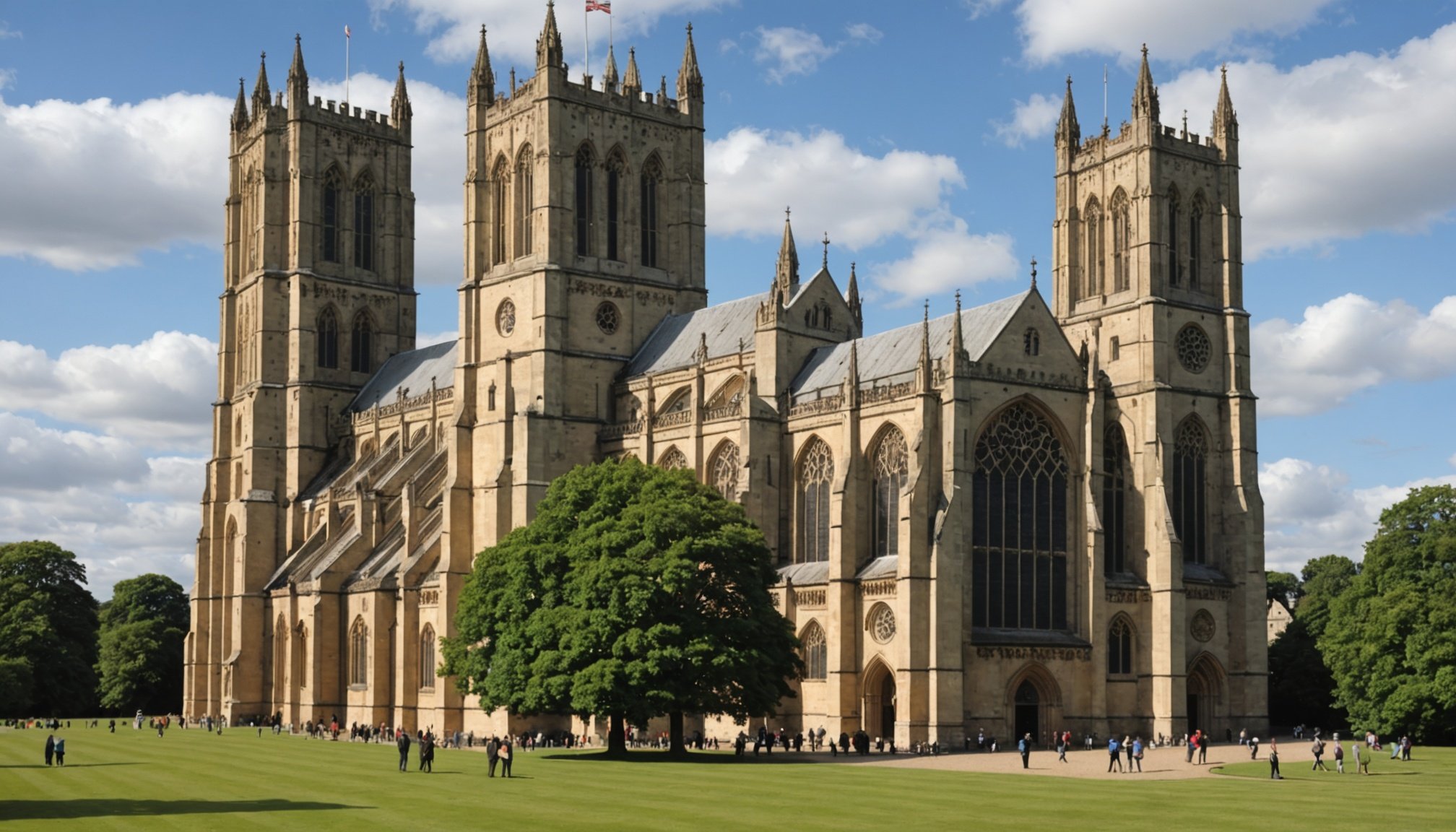Overview of England’s Historic Cathedrals
England is renowned for its cathedrals, each a testament to the country’s rich tapestry of historical architecture and cultural heritage. These monumental structures have played a significant role in English history, serving as more than just places of worship. They stood as centers of community life, education, and political power throughout the centuries.
Cathedrals in England showcase an array of architectural styles reflecting the periods in which they were built. You can witness a journey through time, from the sturdy and austere lines of Romanesque architecture to the towering spires and intricate details of Gothic designs. Each cathedral is unique, with its own blend of styles that have evolved over the centuries, often incorporating local materials and techniques.
The impact of these sacred spaces extends beyond their spiritual significance. They are vital to local culture, often hosting a variety of community and cultural events that draw visitors and tourists alike. These events highlight the cathedrals’ roles as custodians of England’s cultural heritage. Additionally, the influx of tourism brought about by these architectural marvels contributes to the economy of surrounding areas, ensuring their preservation for future generations to admire.
Major Cathedrals to Visit
England boasts a collection of grandiose cathedrals that are not only architectural marvels but also must-see travel destinations. These monumental structures capture historical essence through exquisite design and storied pasts.
Topic to read : Experience the enchantment of an authentic british countryside fair in rural england
Canterbury Cathedral
Canterbury Cathedral stands as a prime example of Britain’s ecclesiastical and architectural legacy. This cathedral is renowned for its Gothic architecture. Key events such as the martyrdom of Archbishop Thomas Becket occurred here, enriching its historical context. Visitors can explore its impressive stained glass windows that narrate biblical stories. With guided tours available, patrons can explore daily from 9 AM to 5 PM, immersing in its deep-rooted history.
York Minster
York Minster is one of the largest Gothic cathedrals in Northern Europe. Its majestic façade and medieval stained glass depict both spiritual and secular scenes. Highlights include the Great East Window. Its extensive visitor facilities offer tours, including the opportunity to ascend the Central Tower. It welcomes visitors daily, though times vary seasonally.
St. Paul’s Cathedral
St. Paul’s Cathedral, with its iconic dome, embodies architectural distinction and historical importance. Designed by Sir Christopher Wren, it reflects English Baroque style. Noteworthy architectural features include the Whispering Gallery. Open to visitors from 8:30 AM to 4:30 PM, guided tours provide insights into its rich history and vital role in London’s tapestry.
Architectural Styles and Features
Exploring the architectural styles of England’s cathedrals reveals a stunning tapestry of design evolution. The Gothic architecture is particularly prominent, characterised by its soaring spires, pointed arches, and intricate stonework. These elements combined create a sense of verticality and light, often seen in the grand cathedrals like York Minster. In contrast, the Romanesque style is distinguished by its rounded arches, thick walls, and sturdy piers, exemplifying strength and solidity.
Beyond the structural forms, unique architectural details enrich each cathedral’s identity. Notably, majestic stained glass windows portray vibrant biblical tales and local histories. These artistic panes not only served a religious purpose but also acted as illuminating artworks for the illiterate masses of the time. Furthermore, exquisite sculptures adorn façades and interiors, often depicting saints, angels, and significant historical figures.
The cathedral’s architectural details and styles aren’t merely decorative; they embody a narrative of England’s shifting cultural and religious landscape. Each sculpture, archway, and window contributes to the story of time, inviting visitors to engage with an era when craftsmanship and artistry were paramount in echoing not only the divine but the community’s spirit.
Cultural and Community Events
The cathedrals of England play a pivotal role in hosting various community events that bolster their reputation as cultural and social epicentres. Major religious celebrations, such as Easter and Christmas services, see thousands of worshippers gather in these majestic spaces, lending these festivities a grandeur only such historic settings can provide.
Beyond religious observances, many cathedrals open their doors to an array of events that celebrate local culture and the arts. Art exhibits frequently adorn the naves, showcasing both historic and contemporary artworks that engage communities in dialogues about heritage and creativity.
Concerts held within the hallowed walls often utilise the superior acoustics of these architectural marvels to enhance musical experiences. Events such as choral festivals and organ recitals become memorable experiences due to the rich soundscape provided by the cathedral’s structure.
Additionally, community gatherings involve educational programmes, workshops, and lectures focused on historical architecture and cultural heritage. These gatherings enrich public understanding and appreciation of the significant roles cathedrals have played in English history.
Through these diverse events, cathedrals transcend their roles as religious sites, becoming vibrant community hubs that enhance cultural understanding and strengthen community bonds.
Travel Tips and Practical Information
When planning your visit to the cathedrals of England, timing and practicality are key to enjoying the historical architecture and cultural heritage to the fullest. Itinerary planning begins with identifying the best times to visit. Consider spring or autumn for milder weather and fewer crowds, as summer tends to bring peak tourist influx.
Understanding the layout and transport options is crucial for navigating between cathedrals. England’s extensive rail network offers convenient connections; however, local bus services or hiring a car can provide more flexibility.
Accommodation varies from charming bed-and-breakfasts to grand hotels. Staying near cathedrals offers easy access and a chance to enjoy the local ambiance. Also explore the many dining options for authentic English cuisine and pub experiences.
For a seamless experience, focus on local guides that provide detailed information about each site, enhancing your understanding of historical contexts and architectural highlights.
Lastly, consider off-peak hours for visits to avoid crowds and ensure a more contemplative atmosphere while absorbing the spiritual and cultural essence of these historic spaces.
Personal Experiences and Anecdotes
Visiting the cathedrals of England offers profound cultural insights and unique encounters, shared through captivation stories of travellers’ adventures. One unforgettable experience comes from a tourist who attended a midsummer concert in the majestic York Minster. The lingering resonances of the choir amidst Gothic arches left an indelible mark of spiritual awe and historical grandeur.
Another visitor fondly recalls spontaneous conversations with local historians during an impromptu tour of Canterbury Cathedral. These interactions offered deeper understanding of its storied past and architectural feats, fueling a newfound admiration for England’s rich historical architecture.
Exploring beyond the mainstream, a traveller recounts a quiet, reflective moment in a secluded chapel at the Lincoln Cathedral. Here, away from bustling crowds, the visitor absorbed the sacred tranquillity, deepening their connection to cultural heritage and personal spirituality.
These personal stories reflect the profound impact that cathedral visits can have on individuals, reshaping their perspectives on history and culture. Such experiences highlight the essence of viewing cathedrals not just as architectural marvels, but as living monuments where histories are felt, and unique stories unfold, inviting every visitor to find their personal connection.
Suggested Itineraries
Thinking about visiting the cathedrals of England? Here’s an exploration guide that combines notable cathedrals with other day trips for an enriching visit.
Begin your journey with a weekend itinerary through the iconic sites of Canterbury Cathedral, York Minster, and St. Paul’s Cathedral. Immerse in the grandeur each represents in both historical architecture and cultural prominence. Allocate a day for each, allowing time for tours and personal reflection within these hallowed spaces.
For a week-long adventure, expand to include the beautiful Lincoln Cathedral and the serene Salisbury Cathedral. This longer itinerary offers a deeper dive into England’s religious and architectural history. Both sites offer unique cultural heritage experiences, from awe-inspiring architecture to rich local stories.
Venture further with off-the-beaten-path explorations, like visiting Ely Cathedral, which surprises with its octagonal lantern and distinctive Norman/Gothic blend. Alternatively, Winchester Cathedral is a hidden gem, famed for its length and exquisite medieval floor tiles.
When planning each visit, consider combining cathedral tours with stops at local historical sites or museums. This approach provides well-rounded insight into the region’s history, enhancing your travel itineraries with diverse and memorable experiences.










